2015.5 Peugeot Boxer engine
[x] Cancel search: enginePage 71 of 276
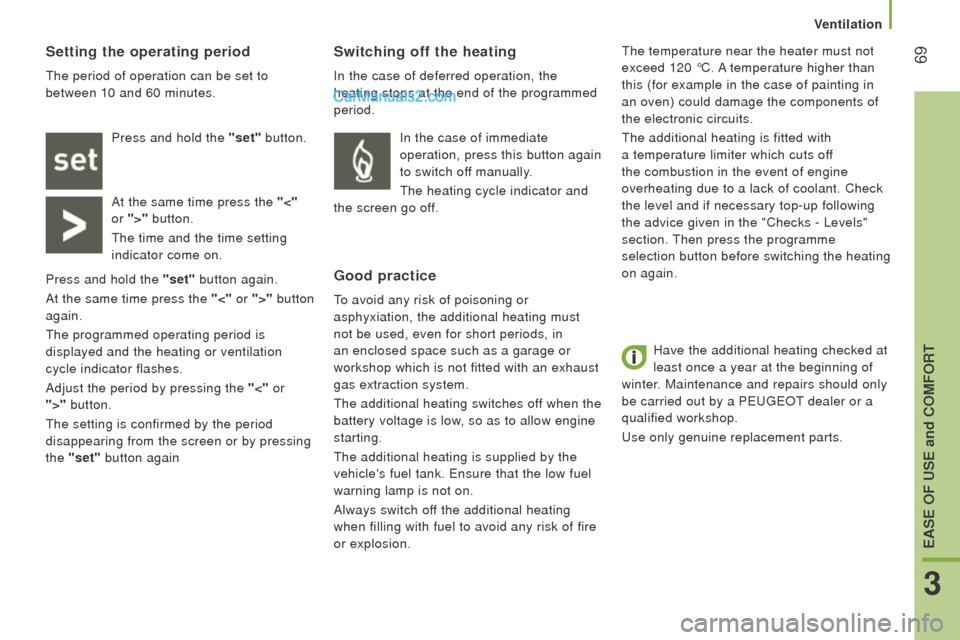
69
Have the additional heating checked at
least once a year at the beginning of
winter. Maintenance and repairs should only
be carried out by a P
eugeOt dealer or a
qualified workshop.
use only genuine replacement parts.
Switching off the heating
In the case of deferred operation, the
heating stops at the end of the programmed
period.
Good practice
to avoid any risk of poisoning or
asphyxiation, the additional heating must
not be used, even for short periods, in
an enclosed space such as a garage or
workshop which is not fitted with an exhaust
gas extraction system.
the additional heating switches of
f when the
battery voltage is low, so as to allow engine
starting.
the additional heating is supplied by the
vehicle's fuel tank.
ensure that the low fuel
warning lamp is not on.
Always switch off the additional heating
when filling with fuel to avoid any risk of fire
or explosion.
the temperature near the heater must not
exceed 120
°C.
A temperature higher than
this (for example in the case of painting in
an oven) could damage the components of
the electronic circuits.
the additional heating is fitted with
a temperature limiter which cuts off
the combustion in the event of engine
overheating due to a lack of coolant. Check
the level and if necessary top-up following
the advice given in the "Checks - Levels"
section.
then press the programme
selection button before switching the heating
on again.
Setting the operating period
the period of operation can be set to
between 10 and 60 minutes.
Press and hold the "set"
button.
At the same time press the "<"
or ">" button.
the time and the time setting
indicator come on.
Press and hold the "set" button again.
At the same time press the "<" or ">" button
again.
the programmed operating period is
displayed and the heating or ventilation
cycle indicator flashes.
Adjust the period by pressing the "<" or
">" button.
the setting is confirmed by the period
disappearing from the screen or by pressing
the "set" button again In the case of immediate
operation, press this button again
to switch off manually.
the heating cycle indicator and
the screen go off.
3
EASE oF uSE and coMFort
Ventilation
Page 72 of 276
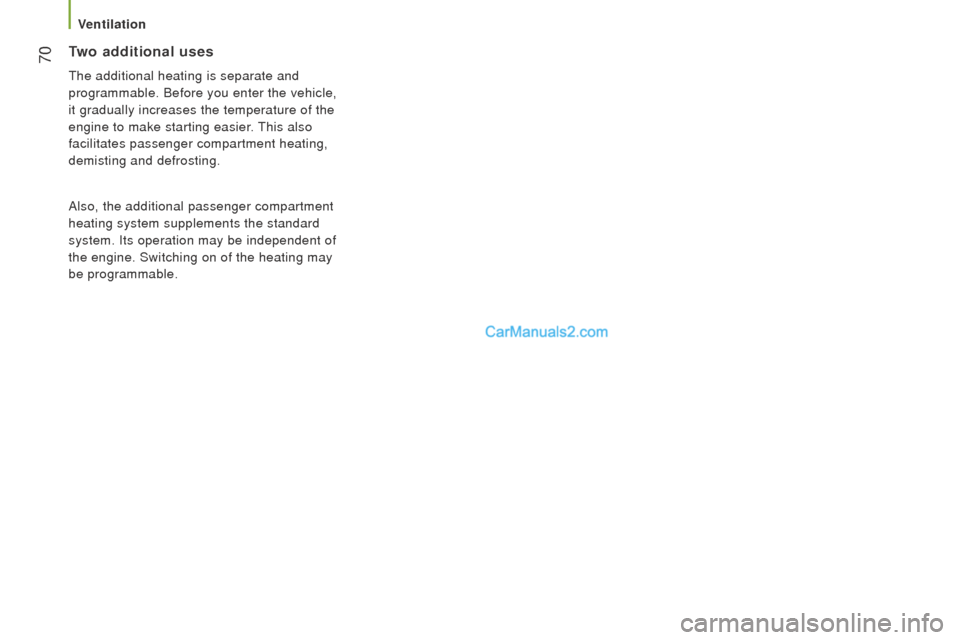
70two additional uses
the additional heating is separate and
programmable. Before you enter the vehicle,
it gradually increases the temperature of the
engine to make starting easier.
this also
facilitates passenger compartment heating,
demisting and defrosting.
Also, the additional passenger compartment
heating system supplements the standard
system. Its operation may be independent of
the engine. Switching on of the heating may
be programmable.
Ventilation
Page 103 of 276
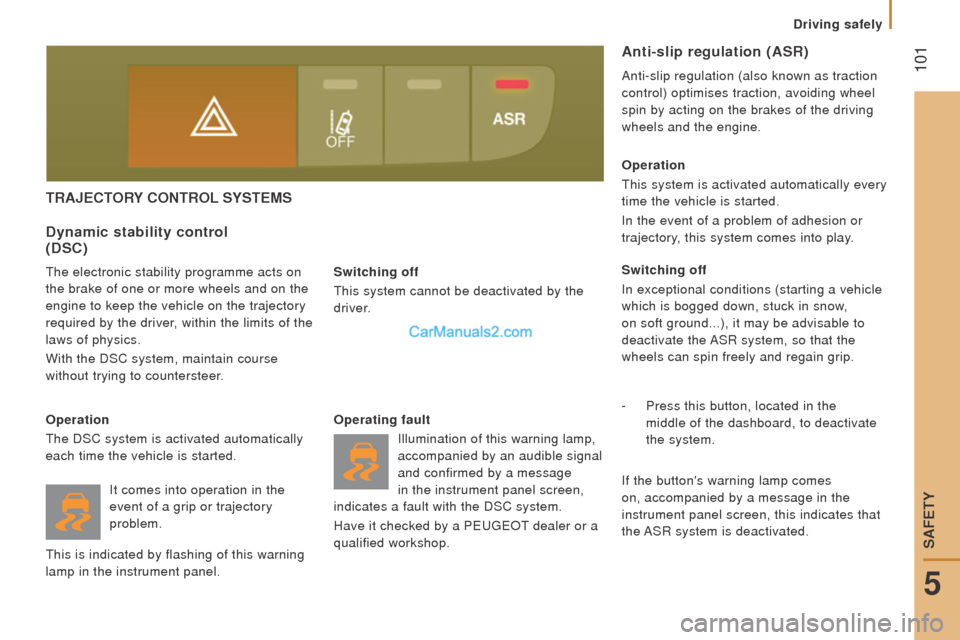
101
trAjEctorY controL SYStEMS
Switching off
this system cannot be deactivated by the
driver.
dynamic stability control
(dSc)
the electronic stability programme acts on
the brake of one or more wheels and on the
engine to keep the vehicle on the trajectory
required by the driver, within the limits of the
laws of physics.
With the DSC system, maintain course
without trying to countersteer.
operation
the DSC system is activated automatically
each time the vehicle is started.
operating fault
Illumination of this warning lamp,
accompanied by an audible signal
and confirmed by a message
in the instrument panel screen,
indicates a fault with the DSC system.
Have it checked by a P
eugeOt dealer or a
qualified workshop.
operation
this system is activated automatically every
time the vehicle is started.
In the event of a problem of adhesion or
trajectory, this system comes into play.
Switching off
In exceptional conditions (starting a vehicle
which is bogged down, stuck in snow,
on soft ground...), it may be advisable to
deactivate the ASR system, so that the
wheels can spin freely and regain grip.
-
Press this button, located in the
middle of the dashboard, to deactivate
the
system.
Anti-slip regulation (ASr)
Anti-slip regulation (also known as traction
control) optimises traction, avoiding wheel
spin by acting on the brakes of the driving
wheels and the engine.
If the button's warning lamp comes
on, accompanied by a message in the
instrument panel screen, this indicates that
the ASR system is deactivated.
It comes into operation in the
event of a grip or trajectory
problem.
this is indicated by flashing of this warning
lamp in the instrument panel.
5
Driving safely
SAFetY
Page 106 of 276
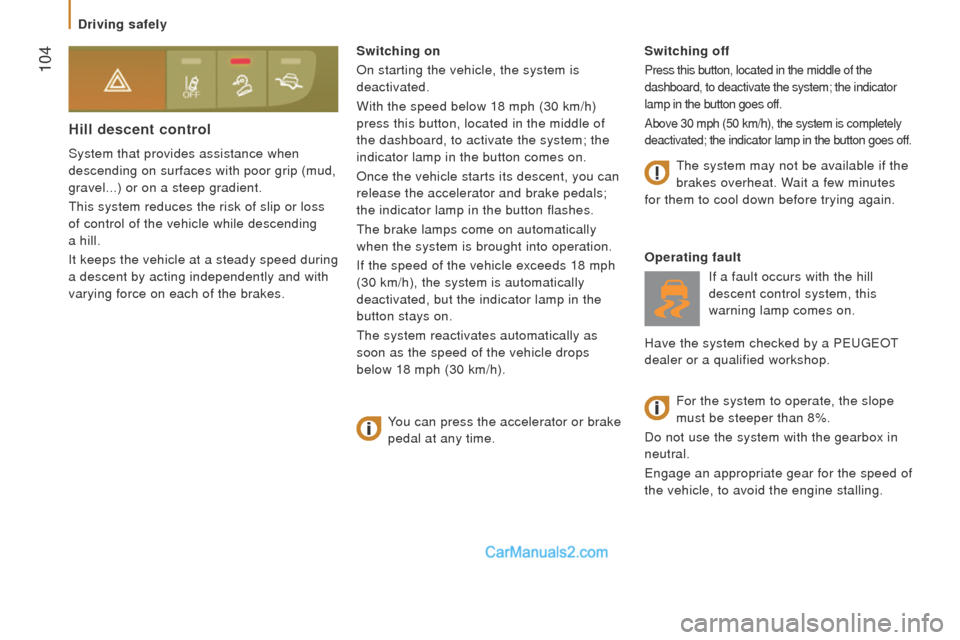
104
Hill descent control
System that provides assistance when
descending on surfaces with poor grip (mud,
gravel...) or on a steep gradient.
this system reduces the risk of slip or loss
of control of the vehicle while descending
a hill.
It keeps the vehicle at a steady speed during
a descent by acting independently and with
varying force on each of the brakes. Switching off
Press this button, located in the middle of the
dashboard, to deactivate the system; the indicator
lamp in the button goes off.
Above 30 mph (50 km/h), the system is completely
deactivated; the indicator lamp in the button goes off.
operating fault
If a fault occurs with the hill
descent control system, this
warning lamp comes on.
Have the system checked by a P
eugeOt
dealer or a qualified workshop.
Switching on
On starting the vehicle, the system is
deactivated.
With the speed below 18 mph (30 km/h)
press this button, located in the middle of
the dashboard, to activate the system; the
indicator lamp in the button comes on.
Once the vehicle starts its descent, you can
release the accelerator and brake pedals;
the indicator lamp in the button flashes.
the brake lamps come on automatically
when the system is brought into operation.
If the speed of the vehicle exceeds 18 mph
(30 km/h), the system is automatically
deactivated, but the indicator lamp in the
button stays on.
the system reactivates automatically as
soon as the speed of the vehicle drops
below 18 mph (30 km/h).
For the system to operate, the slope
must be steeper than 8%.
Do not use the system with the gearbox in
neutral.
engage an appropriate gear for the speed of
the vehicle, to avoid the engine stalling.
You can press the accelerator or brake
pedal at any time.
the system may not be available if the
brakes overheat. Wait a few minutes
for them to cool down before trying again.
Driving safely
Page 108 of 276
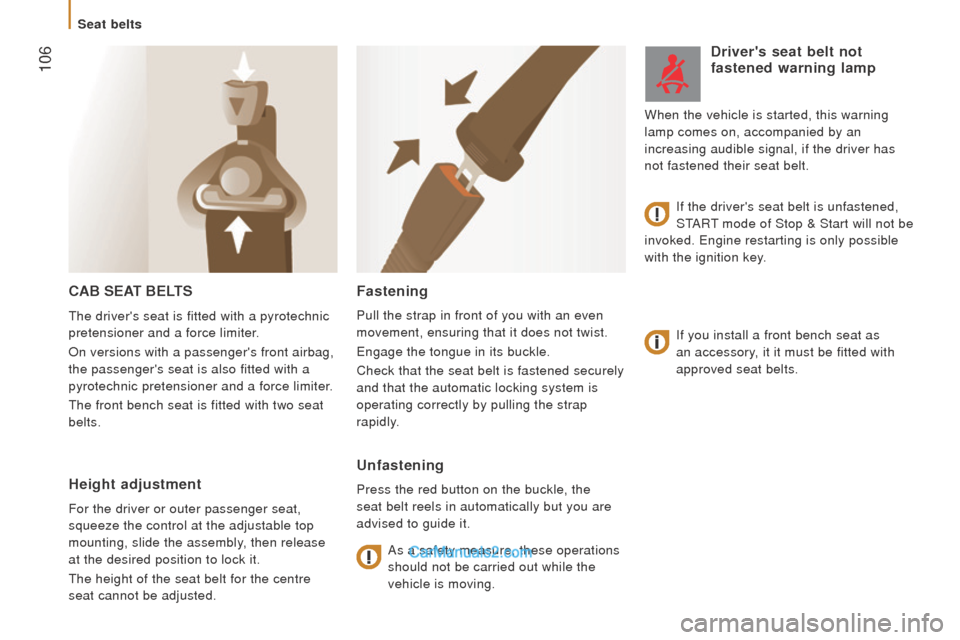
106
cAB SEAt BELtS
If you install a front bench seat as
an accessory, it it must be fitted with
approved seat belts.
Fastening
Pull the strap in front of you with an even
movement, ensuring that it does not twist.
engage the tongue in its buckle.
Check that the seat belt is fastened securely
and that the automatic locking system is
operating correctly by pulling the strap
rapidly.
unfastening
Press the red button on the buckle, the
seat belt reels in automatically but you are
advised to guide it.
As a safety measure, these operations
should not be carried out while the
vehicle is moving.
driver's seat belt not
fastened warning lamp
If the driver's seat belt is unfastened,
S
tARt mode of Stop & Start will not be
invoked.
engine restarting is only possible
with the ignition key. When the vehicle is started, this warning
lamp comes on, accompanied by an
increasing audible signal, if the driver has
not fastened their seat belt.
the driver's seat is fitted with a pyrotechnic
pretensioner and a force limiter.
On versions with a passenger's front airbag,
the passenger's seat is also fitted with a
pyrotechnic pretensioner and a force limiter.
the front bench seat is fitted with two seat
belts.
Height adjustment
For the driver or outer passenger seat,
squeeze the control at the adjustable top
mounting, slide the assembly, then release
at the desired position to lock it.
the height of the seat belt for the centre
seat cannot be adjusted.
Seat belts
Page 111 of 276
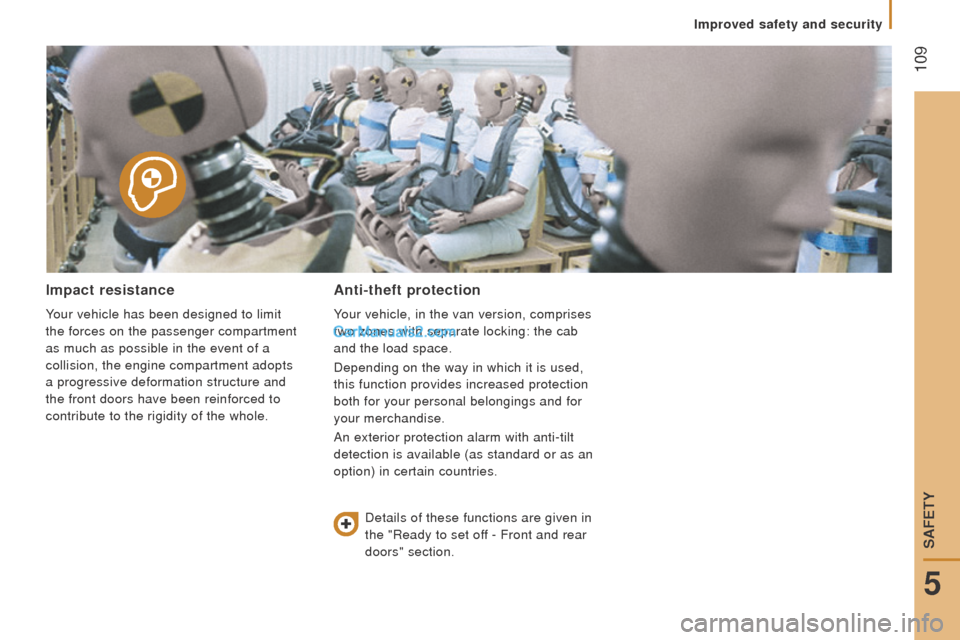
109
Improved safety and security
Impact resistance
Your vehicle has been designed to limit
the forces on the passenger compartment
as much as possible in the event of a
collision, the engine compartment adopts
a progressive deformation structure and
the front doors have been reinforced to
contribute to the rigidity of the whole.
Anti-theft protection
Your vehicle, in the van version, comprises
two zones with separate locking: the cab
and the load space.
Depending on the way in which it is used,
this function provides increased protection
both for your personal belongings and for
your merchandise.
An exterior protection alarm with anti-tilt
detection is available (as standard or as an
option) in certain countries.Details of these functions are given in
the "Ready to set off - Front and rear
doors" section.
5
SAFetY
Page 113 of 276
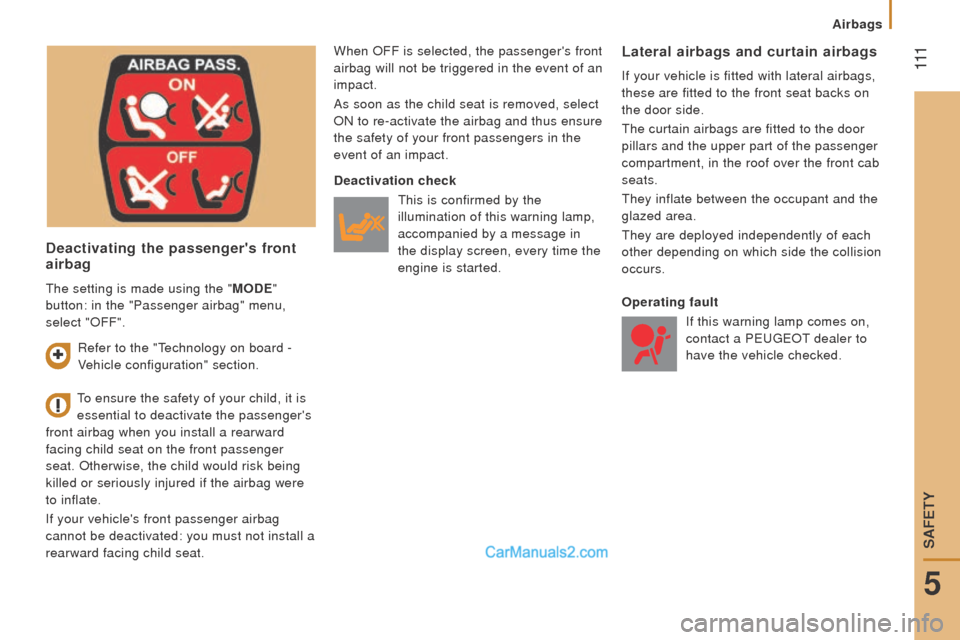
111
deactivating the passenger's front
airbag
When OFF is selected, the passenger's front
airbag will not be triggered in the event of an
impact.
As soon as the child seat is removed, select
ON to re-activate the airbag and thus ensure
the safety of your front passengers in the
event of an impact.Lateral airbags and curtain airbags
If your vehicle is fitted with lateral airbags,
these are fitted to the front seat backs on
the door side.
the curtain airbags are fitted to the door
pillars and the upper part of the passenger
compartment, in the roof over the front cab
seats.
they inflate between the occupant and the
glazed area.
they are deployed independently of each
other depending on which side the collision
occurs.
to ensure the safety of your child, it is
essential to deactivate the passenger's
front airbag when you install a rearward
facing child seat on the front passenger
seat. Otherwise, the child would risk being
killed or seriously injured if the airbag were
to inflate.
If your vehicle's front passenger airbag
cannot be deactivated: you must not install a
rearward facing child seat.
deactivation check
this is confirmed by the
illumination of this warning lamp,
accompanied by a message in
the display screen, every time the
engine is started.
operating fault
If this warning lamp comes on,
contact a P
eugeOt dealer to
have the vehicle checked.
Refer to the "technology on board -
V
ehicle configuration" section.
the setting is made using the "
M
odE
"
button: in the "Passenger airbag" menu,
select "OFF".
5
SAFetY
Airbags
Page 124 of 276
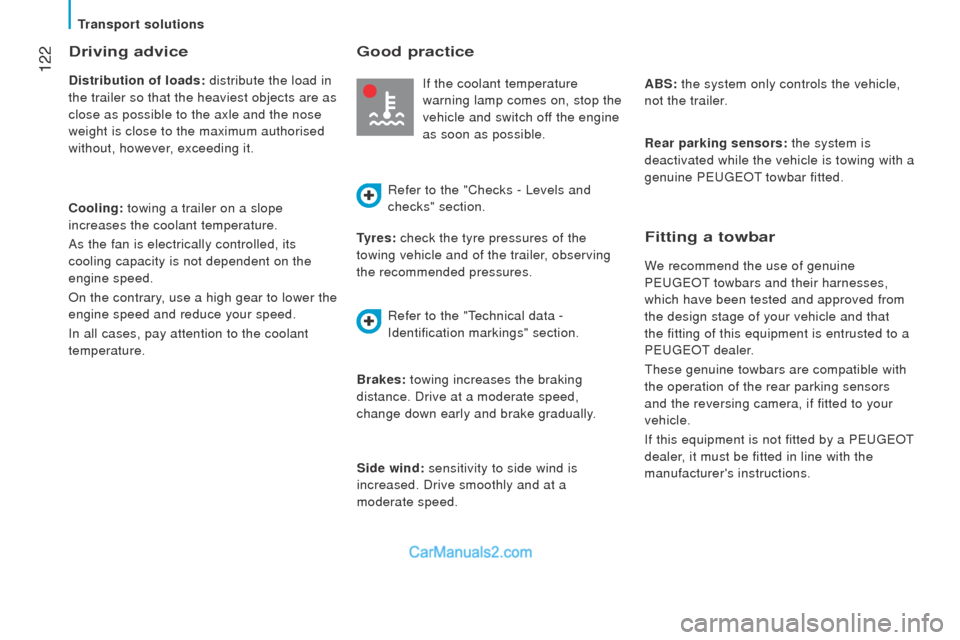
122
driving advice
distribution of loads: distribute the load in
the trailer so that the heaviest objects are as
close as possible to the axle and the nose
weight is close to the maximum authorised
without, however, exceeding it.
cooling:
towing a trailer on a slope
increases the coolant temperature.
As the fan is electrically controlled, its
cooling capacity is not dependent on the
engine speed.
On the contrary, use a high gear to lower the
engine speed and reduce your speed.
In all cases, pay attention to the coolant
temperature.
tyres: check the tyre pressures of the
towing vehicle and of the trailer, observing
the recommended pressures.
Fitting a towbar
We recommend the use of genuine
P
eugeOt towbars and their harnesses,
which have been tested and approved from
the design stage of your vehicle and that
the fitting of this equipment is entrusted to a
P
eugeOt dealer.
these genuine towbars are compatible with
the operation of the rear parking sensors
and the reversing camera, if fitted to your
vehicle.
If this equipment is not fitted by a P
eugeOt
dealer, it must be fitted in line with the
manufacturer's instructions.
Good practice
If the coolant temperature
warning lamp comes on, stop the
vehicle and switch off the engine
as soon as possible.
Refer to the "Checks - Levels and
checks" section.
Brakes: towing increases the braking
distance. Drive at a moderate speed,
change down early and brake gradually. Side wind: sensitivity to side wind is
increased. Drive smoothly and at a
moderate speed. ABS: the system only controls the vehicle,
not the trailer.
rear parking sensors:
the system is
deactivated while the vehicle is towing with a
genuine P
eugeOt towbar fitted.
Refer to the "
technical data -
Identification markings" section.
transport solutions